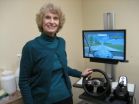(Press-News.org) After hip replacement surgery, many patients are anxious to resume driving, and a new study challenges the conventional wisdom that patients should wait six weeks before getting back behind the wheel. Dr. Geoffrey Westrich, director of research, Adult Reconstruction and Joint Replacement at Hospital for Special Surgery in New York City, found that patients in the study were able to return to driving four weeks after total hip replacement.
The study, titled, "A Novel Assessment of Driving Reaction Time Following THR Using a New Fully Interactive Driving Simulator," will be presented at the annual meeting of the American Academy of Orthopaedic Surgeons in New Orleans on March 11, 2014.
"One of the most common questions patients ask after hip replacement is when they can start driving again, and this is the first study of its kind to test their reaction time after the procedure," said Dr. Westrich, who came up with the idea for the driving simulator while watching his children play video games.
But the interactive simulator used in his study is more intricate than a Wii game. "It's a very sophisticated machine made by a company that makes driving simulators for the automobile industry," Dr. Westrich said.
More than 330,000 hip replacements are performed in the United States each year. People exhibit decreased reaction time after the surgery, making it unsafe to drive in the immediate post-operative period. Most doctors recommend patients wait about six weeks before they resume driving, but many don't want to wait that long.
"Over the past five or 10 years, we've seen advances such as minimally invasive hip replacement and newer implants that are advantageous to patients and may improve recovery time. Our study set out to obtain good, objective data to determine if it would be safe for people to return to driving sooner," Dr. Westrich said.
One-hundred patients from three orthopedic surgeons at Hospital for Special Surgery were enrolled in the study to assess their driving reaction times using a fully-interactive driving simulator with an automatic brake reaction timer from the American Automobile Association.
All of the participants had a total hip replacement on the right side, and they all took the driving test prior to having surgery. They were then randomly selected to repeat the test TWO, THREE or FOUR weeks after hip replacement. Reaction time was measured by the computerized driving simulator.
The reaction timer, equipped with an accelerator and brake pedal, simulates driving. Patients were instructed to place their foot on the accelerator, which activated a green light, and to keep their foot on the accelerator until a Stop sign appeared. When the Stop sign popped up, they were supposed to move their foot to the brake pedal. The amount of time it took for the subject to switch from the gas to the brake pedal was measured by the machine.
The study defined a return to safe driving reaction time as a return to a reaction time that was either the same as or better than the preoperative driving reaction time. Observing reaction times at different intervals revealed that two and three weeks after surgery patients had not yet made a full recovery to their respective baseline reaction time and generally were not ready to drive.
However, at four weeks following hip replacement, patients had actually improved their reaction time compared to what it was before the surgery and therefore could be cleared to drive. It was also observed that patients under the age of 70 reached an improved reaction time earlier than those over 70.
"By using a standardized, driving simulator to measure reaction times, our study will be reproducible and we can apply our model to other surgical procedures that may affect one's ability to drive safely postoperatively," Dr. Westrich noted. He will soon begin enrolling patients in another study to determine when it is safe to drive after total knee replacement.
INFORMATION:
Study Title: A Novel Assessment of Driving Reaction Time Following THR Using a New Fully Interactive Driving Simulator
Author(s): Allison Ruel, BA, New York, New York
Geoffrey H. Westrich, MD, New York, New York
About Hospital for Special Surgery
Founded in 1863, Hospital for Special Surgery (HSS) is a world leader in orthopedics, rheumatology and rehabilitation. HSS is nationally ranked No. 1 in orthopedics, No. 4 in rheumatology, and No. 5 in geriatrics by U.S.News & World Report (2013-14), and is the first hospital in New York State to receive Magnet Recognition for Excellence in Nursing Service from the American Nurses Credentialing Center three consecutive times. HSS has one of the lowest infection rates in the country. From 2007 to 2012, HSS has been a recipient of the HealthGrades Joint Replacement Excellence Award. HSS is a member of the NewYork-Presbyterian Healthcare System and an affiliate of Weill Cornell Medical College and as such all Hospital for Special Surgery medical staff are faculty of Weill Cornell. The hospital's research division is internationally recognized as a leader in the investigation of musculoskeletal and autoimmune diseases. Hospital for Special Surgery is located in New York City and online at http://www.hss.edu.
Study using driving simulator determines when it's safe to drive after hip replacement
Using interactive 'video game' to test reaction time, findings at Hospital for Special Surgery challenge traditional recommendation to wait 6 weeks after hip replacement before driving
2014-03-11
ELSE PRESS RELEASES FROM THIS DATE:
New MRI can 'see through' metal screws to follow patients after hip fracture surgery
2014-03-11
People who sustain the most common type of hip fracture, known as a femoral neck fracture, are at increased risk of complications. A special type of MRI developed at Hospital for Special Surgery in collaboration with GE Healthcare can show a detailed image following fracture repair, without the distortion caused by metal surgical screws that are problematic in standard MRIs.
Each year, more than 340,000 people suffer a broken hip in the United States. The femoral neck, the area just below the ball of the hip's ball-and-socket joint, is the most common site of fracture, ...
Study: Women report more pain than men after knee replacement surgery
2014-03-11
Middle-aged women with rheumatoid arthritis or arthritis resulting from an injury are among the patients most likely to experience serious pain following a knee replacement, researchers from Hospital for Special Surgery (HSS) in New York have found.
One of the biggest concerns patients have is the amount of pain they will have after knee replacement surgery. Although it is a very successful operation overall to relieve arthritis pain and restore function, persistent postoperative pain can be a problem for some patients. Researchers at HSS set out to determine which groups ...
Personality may be key risk factor in preventive health care
2014-03-11
WASHINGTON – When it comes to helping young adults avoid serious health problems later in life, assessing their personalities during routine medical exams could prove as useful as recording their family medical histories and smoking habits, according to new research published by the American Psychological Association.
"Health care reform provides a great opportunity for preventive care, with physicians seeing more young adults who may not previously have had insurance," said lead author Salomon Israel, PhD, of Duke University and Duke University Medical Center. "Our research ...
UGA researchers identify decision-making center of brain
2014-03-11
Athens, Ga. – Although choosing to do something because the perceived benefit outweighs the financial cost is something people do daily, little is known about what happens in the brain when a person makes these kinds of decisions. Studying how these cost-benefit decisions are made when choosing to consume alcohol, University of Georgia associate professor of psychology James MacKillop identified distinct profiles of brain activity that are present when making these decisions.
"We were interested in understanding how the brain makes decisions about drinking alcohol. Particularly, ...
A new cell type is implicated in epilepsy caused by traumatic brain injury
2014-03-11
BOSTON (March 11, 2014) — Traumatic brain injury is a risk factor for epilepsy, though the relationship is not understood. A new study in mice, published in Cerebral Cortex, identifies increased levels of a specific neurotransmitter as a contributing factor connecting traumatic brain injury (TBI) to post-traumatic epilepsy. The findings suggest that damage to brain cells called interneurons disrupts neurotransmitter levels and plays a role in the development of epilepsy after a traumatic brain injury.
The research team, led by David Cantu and Chris Dulla, studied the ...
Scientists unlock potential heart attack drug without side effects
2014-03-11
Melbourne scientists are a step closer to creating a new drug to stop a heart attack in its tracks and reduce the damage caused, without any side effects.
The Monash University research, published today in the journal, Proceedings of the National Academy of Sciences, USA (PNAS), offers new hope to thousands of people who experience heart attacks and heart failure – one of the major causes of death worldwide.
Professors Arthur Christopoulos and Peter Scammells from the Monash Institute of Pharmaceutical Sciences (MIPS) led a team of scientists combining molecular pharmacology ...
Researchers show that bold baboons learn to solve tasks from other baboons
2014-03-11
Baboons learn from other baboons about new food sources – but only if they are bold or anxious – according to a new study published in the journal PeerJ). The results suggest that personality plays a key role in social learning in animals, something previously ignored in animal cognition studies.
Studying animals at the Zoological Society of London's Institute of Zoology Tsaobis Baboon Project in Namibia, the researchers examined how personality influenced whether baboons solved foraging tasks and whether they then demonstrated to others how to solve the tasks. They found ...
Plaques detected in brain scans forecast cognitive impairment
2014-03-11
DURHAM, N.C. -- Brain imaging using radioactive dye can detect early evidence of Alzheimer's disease that may predict future cognitive decline among adults with mild or no cognitive impairment, according to a 36-month follow-up study led by Duke Medicine.
The national, multicenter study confirms earlier findings suggesting that identifying silent beta-amyloid plaque build-up in the brain could help guide care and treatment decisions for patients at risk for Alzheimer's. The findings appeared online March 11, 2014, in Molecular Psychiatry, a Nature Publishing Group journal.
"Our ...
Obesity associated with lower academic attainment in teenage girls, says new study
2014-03-11
Obesity in adolescent girls is associated with lower academic attainment levels throughout their teenage years, a new study has shown.
The research conducted by the Universities of Strathclyde, Dundee, Georgia and Bristol is the most comprehensive study yet carried out into the association between obesity and academic attainment in adolescence. The results are published in the International Journal of Obesity.
The results showed that girls who were obese, as measured by BMI (body mass index) at age 11 had lower academic attainment at 11, 13 and 16 years when compared ...
York U astronomer maps out Earth's place in the universe among 'Council of Giants'
2014-03-11
VIDEO:
An animation that illustrates the positions of the nearby galaxies, including those in the "Council of Giants, " in three dimensions.
Click here for more information.
We live in a galaxy known as the Milky Way – a vast conglomeration of 300 billion stars, planets whizzing around them, and clouds of gas and dust floating in between.
Though it has long been known that the Milky Way and its orbiting companion Andromeda are the dominant members of a small group ...
LAST 30 PRESS RELEASES:
Drone sampling of whale breath reveals first evidence of potentially deadly virus in Arctic
Roman soldiers defending Hadrian’s Wall infected by parasites, study finds
Pinochet’s prisoners were tormented with music but still found solace in it, a new book reveals
Fertility remains high in rural Tanzania despite access to family planning
AI-assisted device can improve autism care access
Kinetic careers
Uncovering how parasitic plants avoid attacking themselves to improve crop resistance
Nanoparticle vaccine strategy could protect against Ebola and other deadly filoviruses
Study finds brain care score can predict risk of stroke across racial groups
Key lung immune cells can intensify allergic reactions
Do hormones explain why women experience more gut pain?
New materials conduct ions in solids as easily as in liquids
Breakthrough of the Year: Renewable energy begins to eclipse fossil fuel-based sources
LLM use is reshaping scientific enterprise by increasing output, reducing quality and more
Introducing LightGen, a chip for ultra-fast, ultra-efficient generative AI
Astronomers see fireworks from violent collisions around nearby star
ACC/AHA issue new guideline on managing congenital heart disease in adults
Cosmic crash caught on camera
Is talented youth nurtured the wrong way? New study shows: top performers develop differently than assumed
Ants: An untapped resource in the development of antibiotics?
Archaeologists use AI to create prehistoric video game
Mitochondria migrate toward the cell membrane in response to high glucose levels
Tiny viral switch offers hope against drug-resistant bacteria
Most parents aware of early peanut introduction guidelines, but confused about details
HPV vaccine can protect against severe lesions of the vulva and vagina
Virtual care provision and emergency department use among children and youth
Quadrivalent HPV vaccine and high-grade vulvovaginal lesions
Insights into dry eyes gained from stem cell-derived tear glands
Researchers identify 166 human pluripotent stem cell lines available for use in clinical applications
Europa Clipper instrument uniquely observed interstellar comet 3I/ATLAS
[Press-News.org] Study using driving simulator determines when it's safe to drive after hip replacementUsing interactive 'video game' to test reaction time, findings at Hospital for Special Surgery challenge traditional recommendation to wait 6 weeks after hip replacement before driving


